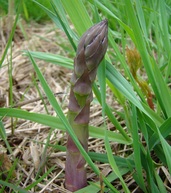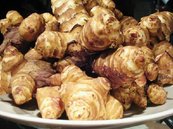Perennial Crops
Asparagus
Asparagus is one of the great joys of seasonal and local eating! Asparagus shipped from Chile in November will never taste the same as local asparagus picked the very same day in April. Why? Because as soon as a stalk of asparagus is picked, the sugars start turning to starch. When asparagus has to travel a long way from its patch to your plate, it loses most of its sweetness. We recommend gorging yourself on fresh asparagus while it’s in season.
While taste is the main reason to eat fresh asparagus, according to the Wikipedia, asparagus is also a low-calorie source of "vitamin B6, calcium, magnesium and zinc, and a very good source of dietary fiber, protein, vitamin A, vitamin C, vitamin E, vitamin K, thiamin, riboflavin, rutin, niacin, folic acid, iron, phosphorus, potassium, copper, manganese and selenium, as well as chromium, a trace mineral that enhances the ability of insulin to transport glucose from the bloodstream into cells.” In 2013, we will be harvesting our young Asparagus beds for about 2 weeks only, most likely in April, before the Urbana or Mahomet farmers’ markets open. If you would like to buy asparagus from us direct, please contact us! Otherwise, we will be selling our asparagus at the Saturday early-spring market at Prairie Fruits Farm in Urbana. |
Rhubarb
If you’re a fan of the Laura
Ingalls Wilder books, you may remember the scene in The First Four Years when Laura makes a pie out of “pie plant” for
the threshers working in her fields and forgets to add sugar. Once you know that pie plant is what we call
rhubarb, you’ll probably understand why this was such a big mistake!
We offer fresh rhubarb throughout the spring and early summer for your pies, crumbles, and sauces (don’t forget the sugar). But don’t stop there—check out our link for rhubarb recipes (below), and consider expanding your rhubarb repertoire to include everything from muffins to a sauce for savory fish dishes. Still not sure what to do with rhubarb? Let us prepare it for you. Check the preserves page of the website for our selection of rhubarb jams, chutneys, and syrups. This year, our rhubarb will be available for purchase at the Urbana and Mahomet farmers’ markets, as well as direct from us at the farm. |
Jerusalem Artichokes
|
